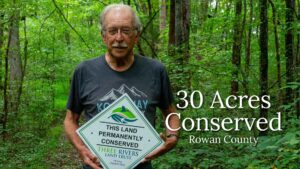
by Crystal Cockman
April 21, 2016
From the Uwharrie National Forest to the many acres of land in private forestry, Montgomery County is an area where forestry is an important industry and forest management an important topic. NC State University and Montgomery Community College are two of the more notable schools for having a great curriculum and degree in Forestry today, but did you know that historically North Carolina is actually the birthplace of modern forest management in North America?
The Biltmore School of Forestry in Asheville North Carolina was the first school of forestry in North America. Carl A. Schenck founded it in 1898. He was brought here by George Vanderbilt from Germany to the Biltmore Estate to manage the forestlands found on the property. Schenck began introducing more scientifically based forest management practices on the property, and found that he spent a lot of time explaining to others the importance of good forestry management. This led to the development of the Biltmore School of forestry.
The Biltmore School of forestry had a one-year course of study, in which much learning occurring hands-on in the forests. The school only lasted until 1909 on the Biltmore estate, but it became the foundation of American forestry education. It also provided America with foresters who were educated with the ideas of conservation.
During his time there Schenck also hosted a three-day forestry fair to celebrate 20 years of forest management at Biltmore and 10 years of the Biltmore Forestry School. Schenck invited many politicians and even the president to the fair, and although none of them came, many other foresters, botanists, professors and more did attend. The fair featured tours of the forest plantations including detailed lessons on forestry practices such as planting techniques, logging operations, seed regeneration, and more.
The former school is now the basis for the Cradle of Forestry in America. This 6500-acre historic site has exhibits about forest history, with a forestry museum, and two trails, which showcase old school buildings, a logging locomotive and a portable sawmill. There is a Forest Discovery Center with interactive exhibits and a movie about a young girl learning to care for and preserve a forest. Exhibits include a helicopter simulator in which visitors can see what it would be like to ride over a forest fire, and one featuring what it would be like to crawl underground and see the creatures that live beneath the forest floor. The Cradle of Forestry is open mid-April through early November daily from 9:00am to 5:00pm. Admission fees are $5 for adults, free for youth, and free for everyone on Tuesdays.
The school grounds are now a part of Pisgah National Forest. In 1914, George Vanderbilt’s widow, Edith, sold more than 86,000 acres to the United States government, including the portion that became the Cradle of Forestry. This was the core of the Pisgah National Forest, which is the first national forest east of the Mississippi. The U.S. Congress established the Cradle of Forestry in 1968 to celebrate the beginning of forestry education in America and encourage interest in forest management today.